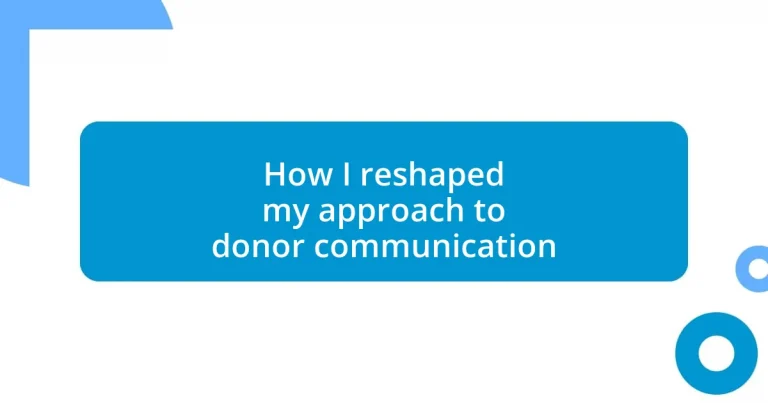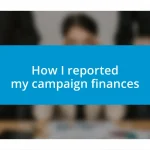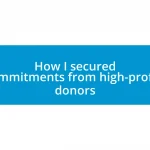Key takeaways:
- Personalizing donor communication significantly increases engagement and connection, transforming one-time supporters into advocates.
- Utilizing storytelling in outreach fosters emotional connections, making donors feel invested in the mission rather than just contributors.
- Leveraging digital tools, like targeted ads and personalized follow-ups, enhances communication effectiveness and builds genuine relationships.
- Regularly measuring engagement and seeking donor feedback is crucial for continuous improvement in communication strategies.
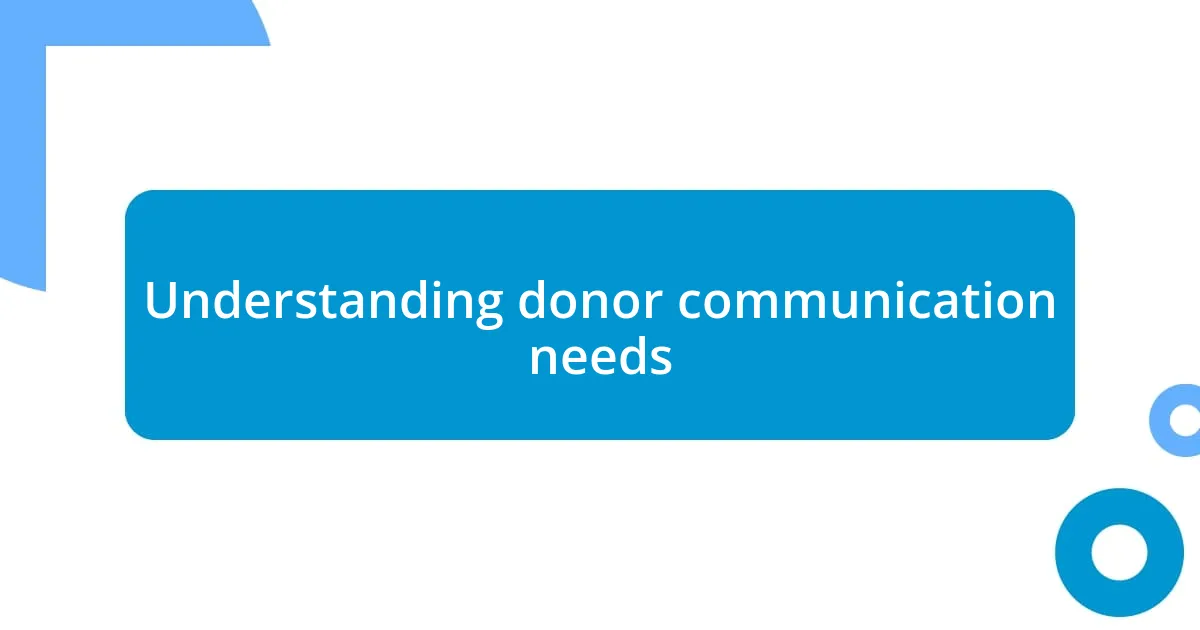
Understanding donor communication needs
Understanding donor communication needs is an intricate dance of empathy and clarity. I remember a time when I casually sent updates to our donors, assuming that just sharing what we did sufficed. It wasn’t until a longtime supporter reached out, questioning why they hadn’t received more personalized communication, that I realized the importance of tailoring my messages to their interests and values. Was I truly acknowledging their contribution, or was I just sending generic updates?
As I delved deeper into donor communication, I discovered that motivations can differ significantly. For some, it’s about seeing the impact of their donations, while for others, it may stem from a need for connection and belonging to a cause they care about deeply. Reflecting on this, I often ask myself, “How can I make my donors feel involved, valued, and informed, rather than just informed?” This realization pushed me to transition from a one-size-fits-all approach to crafting messages that resonate on an individual level.
Listening also plays a crucial role in understanding donor needs. In my experience, asking for feedback often opens doors to insights I hadn’t considered before. I recall conducting a simple survey, which revealed that many donors preferred to receive stories about the beneficiaries of their support, rather than statistics. This revelation was a game-changer for me. It opened my eyes to the emotional power of storytelling in donor communication—a tool that not only informs but also inspires and connects.
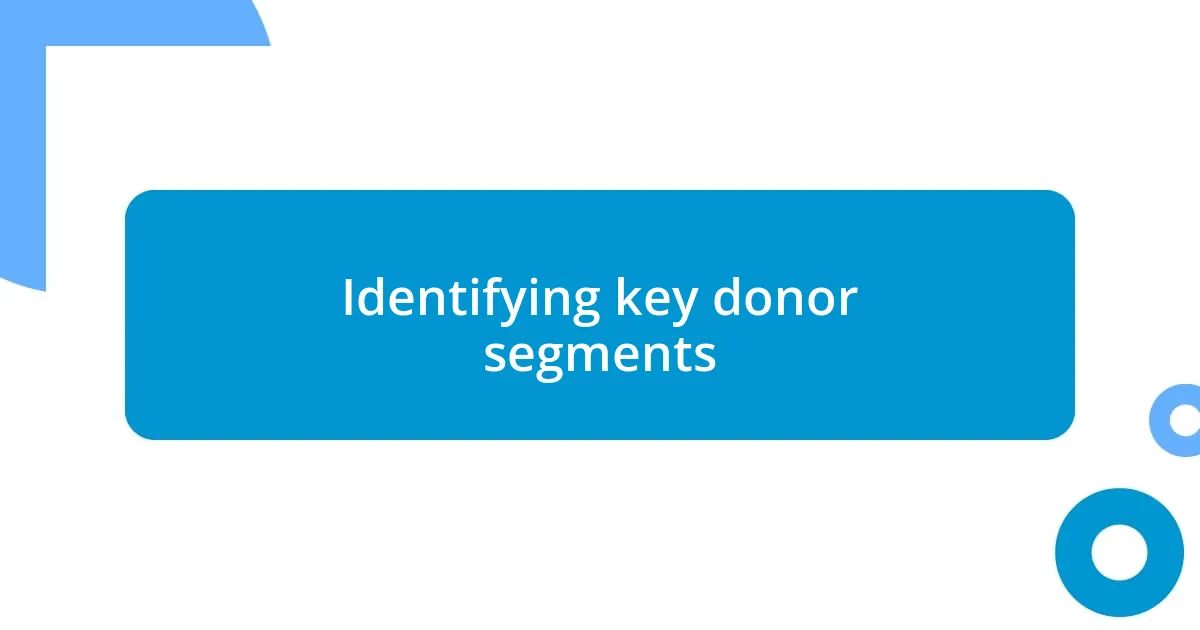
Identifying key donor segments
Identifying key donor segments has been a revelation in my approach to communication. Initially, I treated all donors alike, thinking a generalized message would suffice. But then I stumbled upon the idea of categorizing them based on their giving history, interests, and demographics. This not only enriched my understanding but also enhanced the relevance of my communications.
- First-time donors: Often need reassurance and follow-up to understand the impact of their support.
- Recurring donors: Appreciate updates on projects they’ve supported previously and engagement opportunities.
- Major donors: Seek personalized communication and in-depth insights into strategic impacts and long-term goals.
- Lapsed donors: Require re-engagement strategies—understanding their previous motivations can help rekindle their commitment.
When I revisited my donor list, I noticed a segment that had previously been neglected: those who had contributed just once. I initiated outreach with personalized thank-you notes, expressing genuine gratitude for their support. The responses I received were heartening. Many expressed delight at being recognized and shared their reasons for giving—some had personal experiences tied to my organization’s mission. These insights lit a spark, showing me that even one-time supporters could become advocates if approached thoughtfully. By segmenting donors, I realized I could unlock deeper connections and inspire ongoing engagement.
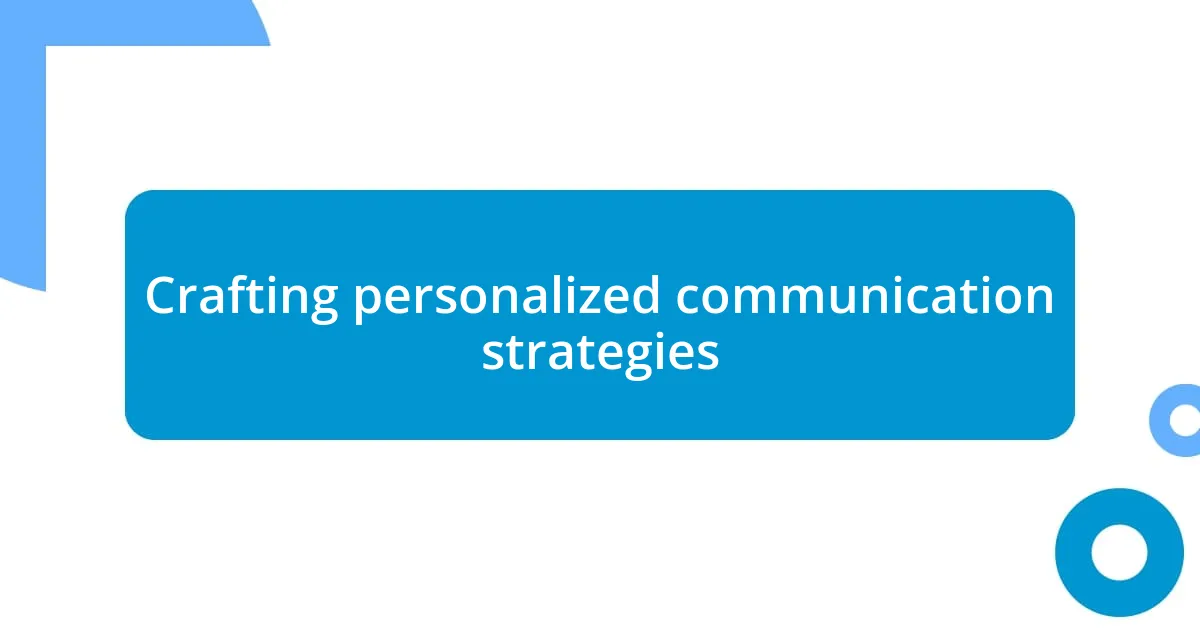
Crafting personalized communication strategies
crafting personalized communication strategies is an essential part of building strong relationships with donors. I remember sitting down to write a thank-you letter for a significant contribution, and instead of just expressing gratitude, I decided to include specific details about how their donation would directly impact a project. I shared a story about a family who would benefit from their generosity. This approach changed everything; the donor responded with such enthusiasm, saying they felt more connected to the cause than ever before. Personalizing communication makes donors feel like they are part of the journey, not just spectators.
In my experience, incorporating their interests or previous involvement into the dialogue can elevate the relationship. For instance, I started to reference specific events or initiatives that matched the donor’s past contributions or expressed interests. One time, I sent targeted invitations to donors who were passionate about environmental initiatives, linking them to a community tree-planting project. Their responses were overwhelmingly positive, with many expressing excitement about being included. Just like that, I learned that crafting messages around a donor’s passions fosters a sense of belonging and relevance.
Creating a variety of communication methods has also proven effective. I discovered that while some donors prefer traditional emails, others are more engaged through social media or personal videos. I initiated a small video update for a select group of major donors, which allowed me to speak directly to them and share the project’s progress visually. The feedback was incredible; one donor even shared, “It felt like you were having a chat with us over coffee!” This experience highlighted how diverse strategies can cater to individual preferences and strengthen connections over time.
| Donor Type | Preferred Communication |
|---|---|
| First-time donors | Follow-up letters highlighting impact |
| Recurring donors | Project updates with personal stories |
| Major donors | In-depth insights and personal videos |
| Lapsed donors | Re-engagement letters with targeted narratives |
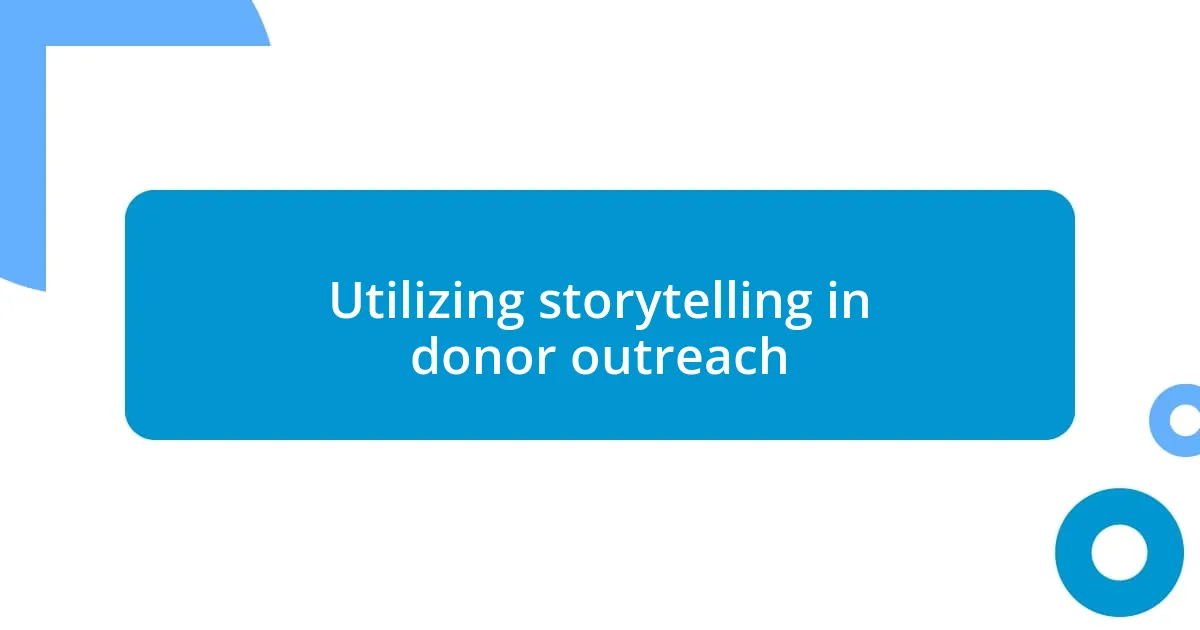
Utilizing storytelling in donor outreach
When I began utilizing storytelling in donor outreach, it almost felt like magic. I remember crafting an email where I shared the journey of a young girl, Maria, who gained access to education through our scholarship program. By detailing her challenges and triumphs, I saw the profound impact a simple story could have. Donors wrote back, moved and eager to contribute more because they felt a connection to Maria’s experience—it was no longer just a donation; it became a shared journey. Have you ever noticed how a good story makes you lean in closer? That’s exactly what happened here.
Sharing stories can tap into emotions that statistics simply can’t. I learned this firsthand when I organized a fundraising dinner and decided to invite one of our program alumni to speak. He shared his story of overcoming adversity and how the support from donors changed his life. The room fell silent as everyone listened intently. In that moment, I realized that the numbers we often cite—like amounts raised—pale in comparison to the raw, emotional power of a personal story. It wasn’t just about funding; it was about inspiring passion and creating advocates for our mission.
Sometimes, I even encourage donors to share their own stories in return. Recently, I launched a campaign inviting supporters to narrate why they chose to donate. The response was heartwarming; it fostered a sense of community, and I was amazed at how many were willing to share such intimate details. This two-way storytelling enriched our relationship, making it clear that each donor’s experience adds a unique thread to the larger tapestry of our organization. Have you thought about how sharing these narratives could reshape your outreach? It’s truly a game-changer.
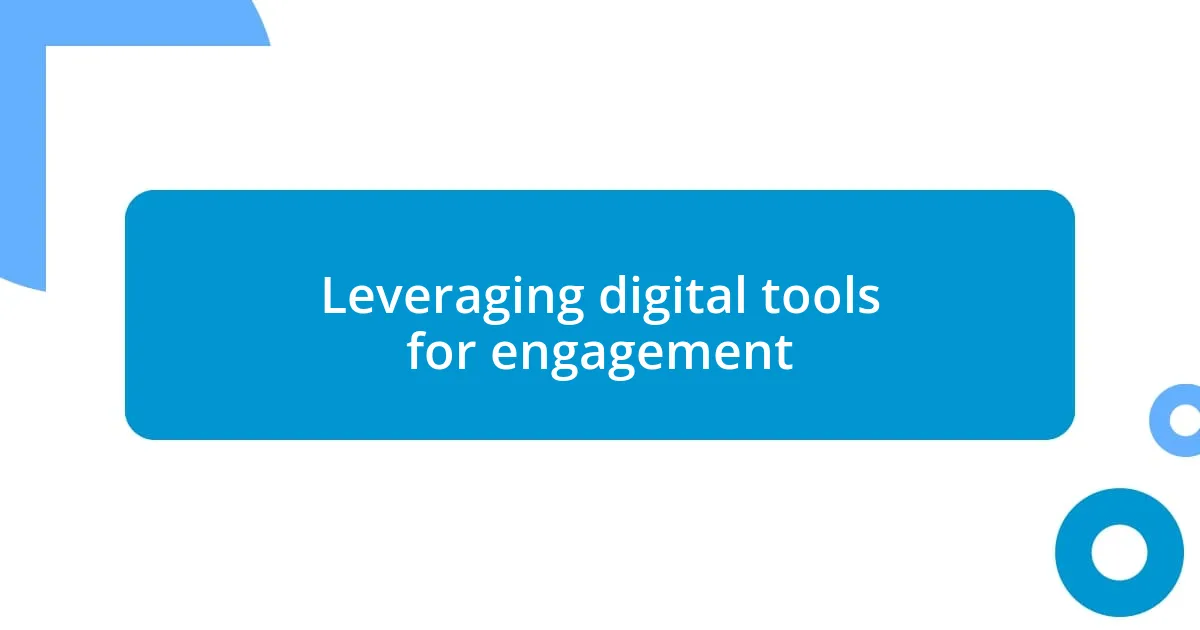
Leveraging digital tools for engagement
One of the most impactful changes I made in my donor communication was leveraging digital tools like emails and social media. I remember when I started using targeted Facebook ads to connect with specific donor segments. The engagement was astonishing! By tailoring content that resonated with different audiences, I saw an increase in clicks and shares. This not only expanded our reach but also fostered a more vibrant conversation around our cause. Have you ever felt that spark of excitement when a message resonates deeply? It’s a feeling I chase every day in my outreach.
Then, I discovered the power of webinars and virtual events. I organized a live Q&A session with our team, inviting donors to come and learn about ongoing projects. It felt more like a friendly chat than a presentation. I remember one donor saying afterward that they appreciated being included in our discussions—it made them feel valued and informed. These digital platforms erased geographical barriers and created a more inclusive atmosphere where everyone could share their thoughts. Isn’t it incredible how technology can break down walls in communication?
Lastly, incorporating personalized follow-up messages through tools like CRM software completely transformed my approach. After an online fundraiser, I made it a point to send tailored “thank you” videos to participants. I recall a moment when a donor replied, expressing how special it made them feel to receive a personal message. They said it was the best part of their week! This simple yet effective use of digital tools changed the way my supporters viewed our organization, shifting from a transactional relationship to one based on genuine connection and engagement. How do you think personalized communication could change the game for your outreach?
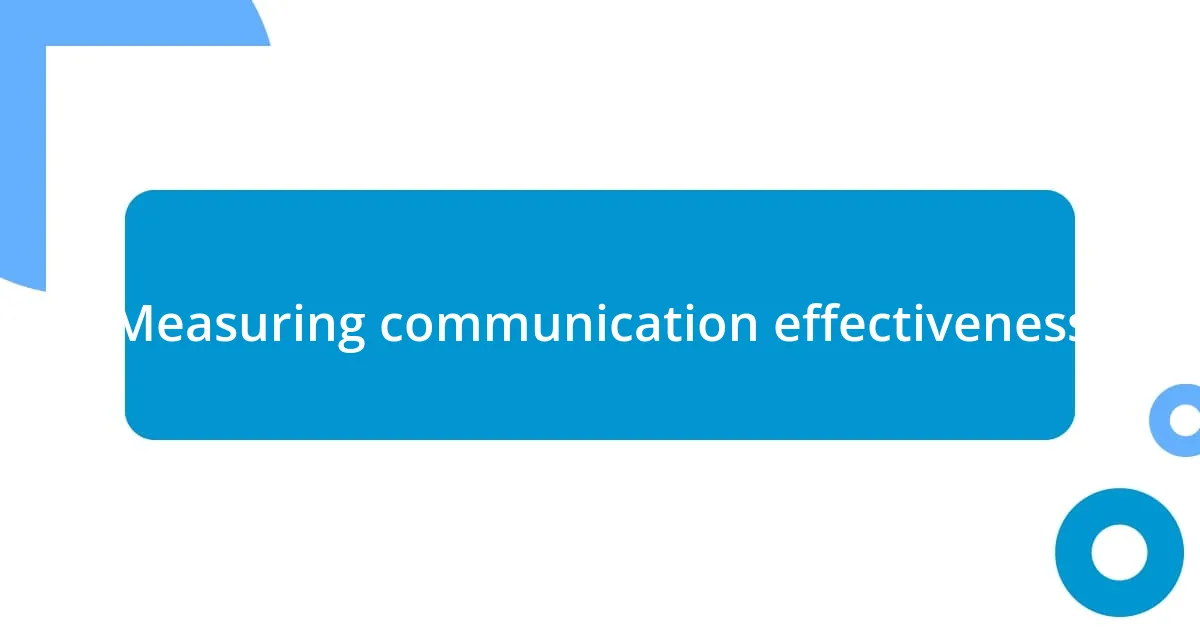
Measuring communication effectiveness
Measuring the effectiveness of communication with donors can feel overwhelming, but it doesn’t have to be. I learned the importance of tracking specific metrics—like open rates and response rates—to gauge how well my messages resonate. One time, after implementing a new email campaign, I noticed a significant jump in both metrics, which told me I was on the right track. Have you ever felt that rush of excitement when you realize your strategy is working?
In my journey, I also began using surveys to collect qualitative data about donor sentiments. During one campaign, I sent out a brief survey after a major event, asking donors how they felt and what motivated them to engage. The responses opened my eyes to new perspectives and highlighted what truly mattered to them. It was incredibly rewarding to hear directly from them, creating a stronger bond in the process. How often do you seek feedback to strengthen your connection with donors?
Analyzing my social media engagement became another key aspect of measuring communication effectiveness. I recall posting a heartfelt thank-you video that unexpectedly went viral among our supporters. The shares and comments flooded in, confirming that my message reached far beyond our usual audience. This experience taught me that effective communication isn’t merely about delivering a message—it’s about sparking conversations and fostering community. What do you think might change in your communication approach if you began measuring engagement like this?
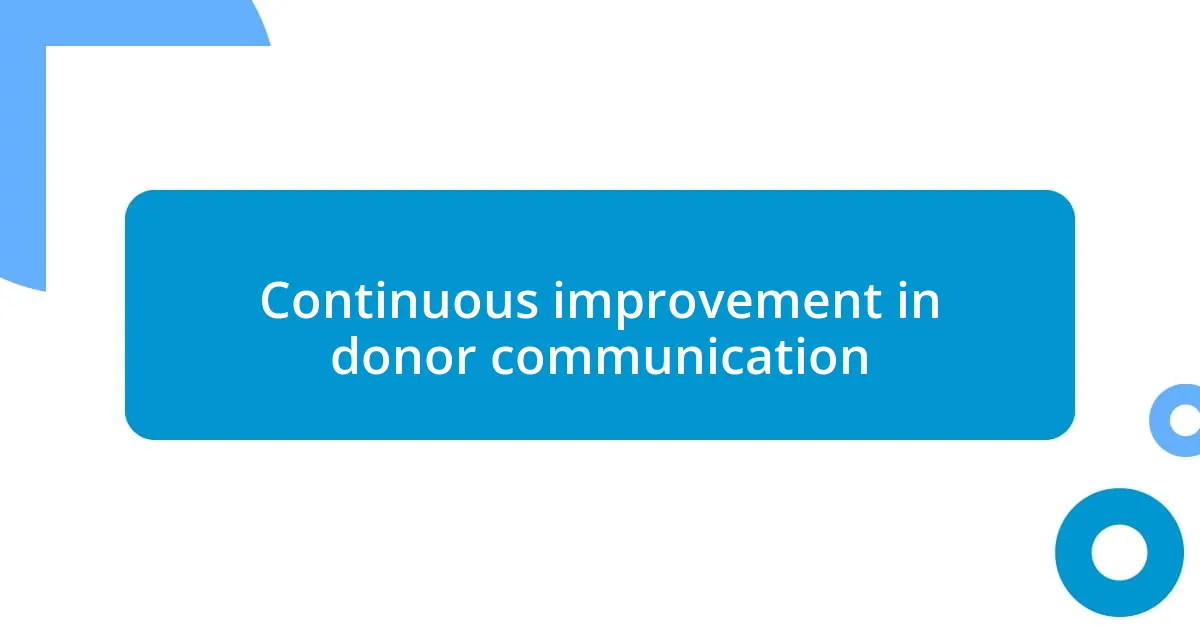
Continuous improvement in donor communication
When I think about continuous improvement in donor communication, I see it as a dynamic process that demands regular reflection and adaptation. After every campaign, I set aside time to review what worked and what didn’t. For example, during one project, I noticed our messaging was too formal, which didn’t resonate with our younger donors. By shifting to a more approachable tone in our emails, the response rate soared! Have you ever stumbled upon a simple tweak that made a world of difference?
I also began prioritizing ongoing donor feedback as a vital part of my strategy. Specifically, I started hosting casual feedback sessions where donors could share their thoughts openly. It was eye-opening to hear their suggestions firsthand; one donor described feeling overwhelmed by information overload. Inspired by this, I simplified our updates into bite-sized pieces. This change made our communication clearer and more digestible, which I believe strengthened our relationship. Isn’t fascinating how listening can lead to such impactful changes?
Moreover, I invested time in training my team on best practices for engaging with donors. I recall a moment when we introduced role-playing exercises on how to handle donor inquiries. One of my colleagues said it transformed her confidence in communication, which in turn improved her interactions with donors. It was a reminder that enhancing our skills is just as crucial as the tools we use. How often do you evaluate the methods your team utilizes in donor communication?












